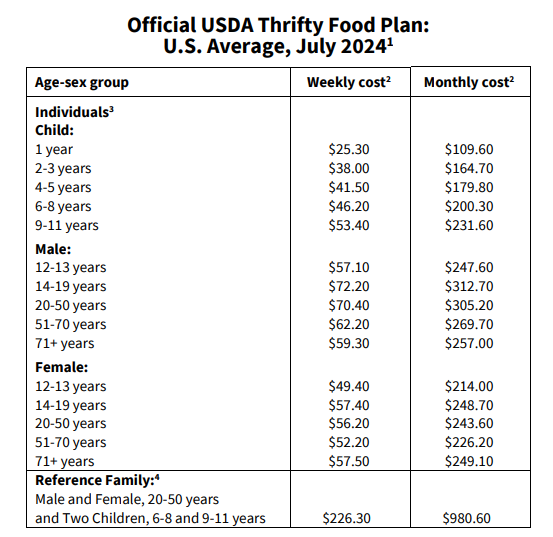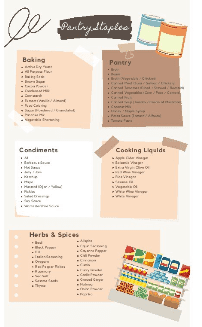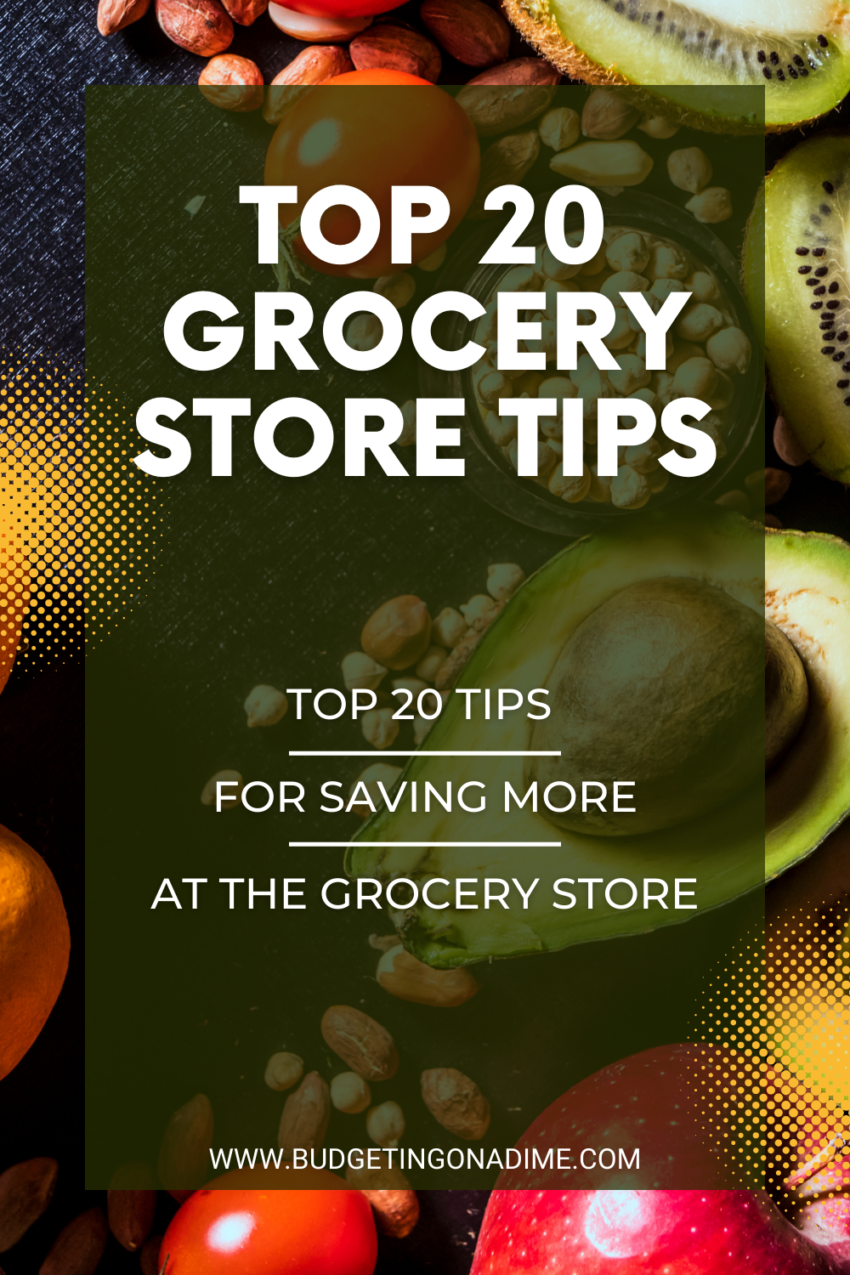I have a love-hate relationship with grocery stores. It’s my happy place at the end of a hard day. I live for the hunt of a great deal. But inflation has not made saving money easy these days.
In 2016, when I started saving money to buy my home, I had to tighten my budget. Of course I started with my food budget. It’s the easiest thing to adjust quickly. I decided I was going to limit my budget to $3 a day. I know this sounds crazy but bear with me, because I was determined to make it work. For over an entire year, I stuck to this and surprisingly, with only a few hiccups along the way, it worked! I was able to put aside extra money for a down payment and as a bonus – I learned how much money I was truly wasting.
Now I know what you are asking… Is this option still a possibility with the inflation we’ve seen since 2020? I think it is, and I’m proof it’s possible. Luckily I have a few advantages like being open to trying different brands. I also don’t buy meat, but I have been shopping on a $90/month budget for the last 8 years.
This will be more of a challenge if you have picky eaters or are loyal to certain brands, but if you sit down and make a plan, reducing expenses is still a possibility.
The USDA publishes a monthly food report that breaks down what thrifty food plans look like. Lots of factors will go into this. Do you have a teenage boy? A special diet? But this is a good place to start to determine how much you want to spend.

Consider that cutting just $10 a month from your groceries could help you save $120 a year. While that seems small it can potentially grow to nearly an extra $5000 after 25 years.
Just $10 a month.
Think how much you can save by doubling or tripling that number.
I may earn a small commission via affiliate links in this post. This is at no extra cost to you! Read the full disclosure here.
20 Tips to Help you Save at the Grocery Store
Plan your menu around sales
Check your sales ads and base your list around that. Try to only add items on sale. Do this with multiple stores but try to limit it to stores close to you. Let’s be honest, it makes no sense to drive all over town to save 50 cents on milk.
Check Cashback Apps
I used to start with this step and found I was adding unnecessary items that I didn’t need or want. I was just buying them to get the next bonus. While I did receive a lot of cash back, it was more than I needed to spend. And more often than not, the food ended up in the trash.
Check the items from your list against apps like Ibotta (use my referral code g9ztua to receive a $5 sign-on bonus) or Fetch (use my referral code FD8KB to receive 1000 points immediately).
Make a habit of checking the “free after purchase” or “best value” section as. You never know what you might find!
Check for necessities
Keep a running list of items you need and keep an eye out sales. There’s nothing worse than having to return to the store when you realize you are out of coffee AND it’s on sale. Coffee is an absolute must in my household. If you are running back to the store 3-4 times for items you forgot, you run a much higher chance of making impulse purchases. I cringe just thinking about all the gas and time wasted.
Keep an inventory list for pantry and freezer. When you open the last of something mark it off and add it to your list.
Stock up on pantry staples when they are on sale
It’s my goal in life to never buy anything at full price. The only way to accomplish this is by stocking up on pantry staples when they are on sale. For example, if you know you use four jars of sauce a month, and they are on sale buy enough for two or three months. That can save a significant amount of money throughout long-term.
This can also help considerably with meal planning on months your budget might be a little tighter.

Download My Pantry Staples List Here
Try tracking items you buy regularly so you can find how often they list a specific brand on sale. When they go on sale, buy enough to last until the next expected sale.
Flipp is an app where you can search items and it lists all the active sales for that item. It includes both in-store and online sales so you can choose the best option.
Download My Grocery Sale Tracker Here
Clip online coupons
See if you grocery store app has the ability to clip coupons online. If they do, start clipping. Literally anything you might one day buy. If you end up buying it one day, the coupon automatically gets applied.
Double-check your list before you head to the store
Before you head to the store double-check that you haven’t forgotten anything or added unnecessary items. If you made lists for multiple stores cross-reference – if anything is on both lists, remove it from the more expensive store.
Take advantage of grocery store apps
If your grocery store app sorts the list by aisle use it. Avoid going down the aisles if you don’t need anything. This will help deter impulse purchases.
Use the smallest cart possible
If you’re a weekly shopper like me, stick to the small cart. If your list is super small grab a basket instead. This will help you stay mindful about how much you’re buying.
Never shop hungry
This should go without saying, but seriously – never do this!
Use a calculator
Keep a running total of items in your cart. If you go over your budget, see what you can remove. If you need everything on the list, buy it all and cut back next week.
While I shop with a weekly amount in mind, I use a monthly budget. As a result, there are weeks when I buy very little, and there are other weeks when I exceed my budget. Like everything else in life, it’s about finding a balance.
Stick to your list
I am a stickler about this one. Every time I go over my monthly budget, I can trace it back to impulse buying.
If sticking to a grocery list is a struggle, consider using online store pick-up or grocery delivery services. Many stores offer free pick-up, and even if there’s a fee, it could still save you more than giving in to impulse buys. For instance, Kroger’s Boost Program waives delivery fees for an annual fee, potentially saving you on gas and last-minute purchases. Services like Instacart also partner with multiple stores, often offering deals that can make delivery as affordable as doing the shopping yourself.
Another great option is the Walmart+ subscription, which offers unlimited free deliveries on orders over $35, plus other perks like discounts on gas and access to exclusive deals. With plans that start monthly or annually, it’s worth considering for families who shop frequently or want to avoid extra trips. If you are on many government assistance programs the cost is even cheaper!
Be honest about your shopping habits and choose the option that best fits your family’s needs and budget.
Split up and freeze
If you know you won’t use something before it goes bad, take action right away—split it into portion sizes and freeze it! The best approach will depend on your family size and how often you shop.
For example, as someone living in a one-person household, I never finish a loaf of bread before it starts to mold. So, I immediately divide it into smaller portions, pop them in freezer bags, and keep all but one in the freezer. When I need more, I just thaw another portion. It’s that easy!
Another great hack I love is stocking up on shredded cheese when it goes on sale at my local grocery store (because who doesn’t need cheese on hand at all times?). My store offers major discounts on it about every 4-5 weeks, so I buy enough to last me until the next sale and freeze it. It’s convenient, saves money, and helps cut down on food waste!
Related: Read the best foods to freeze list here!
Keep an organized pantry/freezer/fridge
Disorganized food storage is a silent budget killer. How many times have you arrived home from the store only to realize you bought pasta sauce and you already have 4 in your pantry?
Try to organize your pantry like a grocery store and keep like items together. When you put food away, move the oldest to the front (if you have ever worked in the restaurant business, I’m sure this in ingrained into you). New freezer items go to the back as well. Always try to incorporate the oldest items into your meal planning for the week.
Make a dedicated section in your fridge for items that need to be used first. I use a storage bin to make these items easily accessible. When cooking, plan around this section first. Supercook is a fantastic app that helps plan meals around what you have on hand. It also has an amazing pantry inventory list, so you always know what you have. And you can add by voice!
Final Thoughts: Saving Money at the Grocery Store
- Sign up for the loyalty programs your stores offer. My store sends me a $3 off $10 coupon at least twice a month!
- Steer clear of toiletries/paper products at the grocery store. Unless there is an exceptional promotion these items are generally far cheaper at big box stores. Pharmacies sometimes run decent promotions on these items as well.
- Pay attention to the price per unit. Always look at the top and bottom level shelves and compare the sale prices price per unit against these items.
- Use what you have on hand. Do your best to not make extra trips between your planned trips. If you have a stocked pantry as suggested, try googling alternatives for what you need. Chances are you have a substitution readily available.
- Buy seasonal items and freeze for later in the year.
- Try having a meat-free night once a week. Although not for everyone, not buying meat is the key to my $90 monthly budget.
- Try a no-spend week (or month)! Commit to only using items you have on hand. Be creative and see what you can come up with.
Although tips for saving money are helpful, it requires a considerable amount of effort to stick to the habit. People tend to become complacent and building habits takes time. But with consistency and time, these habits can become second nature, leading to significantly saving money in the long run.








3 thoughts on “The Ultimate List of Tips for Saving Money on Groceries”
Comments are closed.